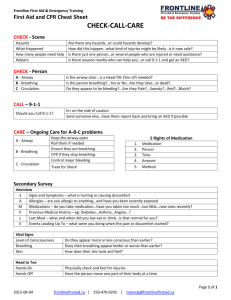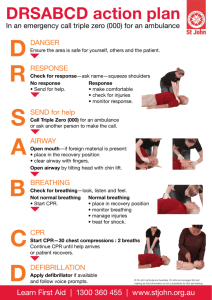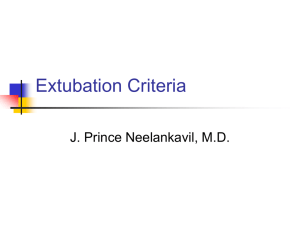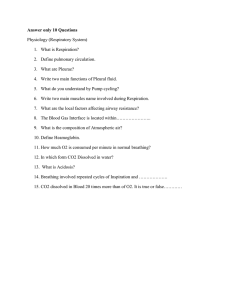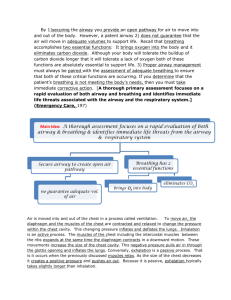Chapter 44 Pediatrics 44-1
advertisement
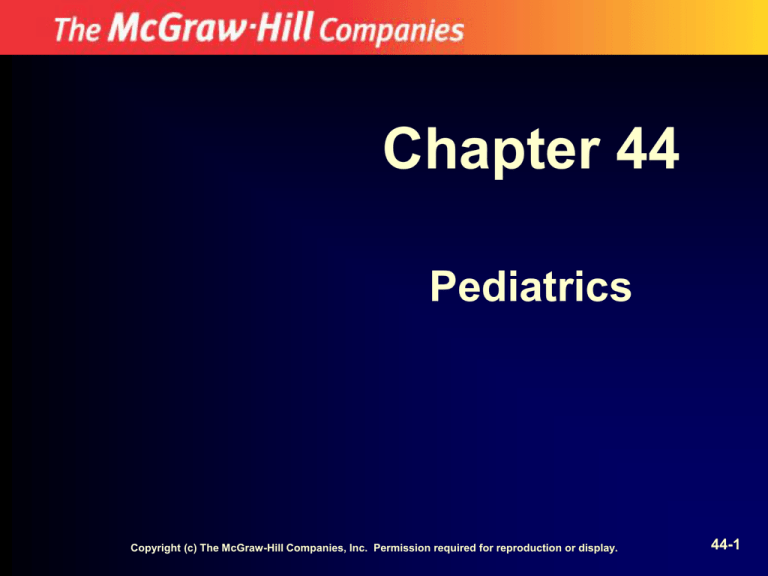
Chapter 44 Pediatrics Copyright (c) The McGraw-Hill Companies, Inc. Permission required for reproduction or display. 44-1 Objectives 44-2 Introduction • Children are not just small adults • Children have unique physical, mental, emotional, and developmental characteristics 44-3 Life Stage Age Newly born Birth to several hours after birth Neonate Birth to 1 month Infant 1 to 12 months of age • Young infant: 0 – 6 months • Older infant: 6 months – 1 year Toddler 1 to 3 years of age Preschooler 4 to 5 years of age School-age 6 to 12 years of age child Adolescent 13 to 18 years of age Anatomical and Physiological Differences in Children 44-5 Head 44-6 Face • Nasal passages – Small, short, and narrow – Easily obstructed – Can lead to respiratory difficulty – Make sure a newborn’s nose is clear to avoid breathing problems 44-7 Face • Mouth opening is usually small • Tongue – Fills the majority of space in the mouth of an infant or child – Most common cause of upper airway obstruction in unconscious child 44-8 Airway • Opening between the vocal cords is higher in the neck and more toward the front than in adults – Flap of cartilage that covers this opening, the epiglottis, is long, floppy, narrow and extends at a 45-degree angle into airway in children – Damage or swelling in this area can block the airway 44-9 Airway • Trachea (windpipe) – Softer, more flexible, smaller diameter, and shorter length than in adults – Rings of cartilage keep windpipe open • Soft and collapses easily in children • Extending or flexing the neck too far can block the airway 44-10 Breathing • Ribs – Soft, flexible – Made up mostly of cartilage – Trauma to the chest is transmitted to lungs and other internal structures more easily 44-11 Breathing • Intercostal muscles – Not fully developed until later in childhood • Diaphragm – Primary muscle of breathing 44-12 Normal Respiratory Rates in Children at Rest Life Stage Age Breaths per Minute Birth to 1 month 1 to 12 months 30-50 Toddler 1 to 3 years 20-30 Preschooler 4 to 5 years 20-30 School-age child Adolescent 6 to 12 years 16-30 13 to 18 years 12-20 Newborn Infant 20-40 44-13 Breathing • Higher oxygen demand per kilogram of body weight – About twice that of an adolescent or adult • Smaller lung oxygen reserves • Increased risk of hypoxia with apnea or ineffective bag-mask ventilation 44-14 Circulation • Infants and child have a blood volume of about 80 mL/kg – Serious volume loss: • Child – sudden loss of 1/2 L (500 mL) • Infant – sudden loss of 100-200 mL 44-15 Normal Heart Rates in Children at Rest Life Stage Age Beats per Minute Newborn Birth to 1 month 120-160 Infant 1 to 12 months 80-140 Toddler 1 to 3 years 80-130 Preschooler 4 to 5 years 80-120 School-age child Adolescent 6 to 12 years 70-110 13 to 18 years 60-100 44-16 Blood Pressure • Measure the blood pressure (BP) in children older than 3 years of age • The BP of a child is normally lower than that of an adult 44-17 Blood Pressure • Use the following formula to determine the lower limit of a normal systolic blood pressure in children 1 to 10 years of age: Systolic Pressure= 70 + (2 X child’s age in years) 37-18 Metabolism and Temperature Regulation • Limited glucose stores • Sensitive to extremes of heat and cold – Large body surface area (BSA) when compared with weight • Greater area of heat loss – Poorly developed temperature-regulating mechanisms 44-19 Skin • Pale (whitish) – Shock, fright, anxiety • Bluish (cyanotic) – Inadequate breathing or poor perfusion – Critical sign; requires immediate treatment • Blotchy (mottled) – Shock, hypothermia, or cardiac arrest • Flushed (red) – Fever, heat exposure, allergic reaction 44-20 Abdomen • Abdominal muscles less developed – Situated more anteriorly – Provide less protection of rib cage • Seemingly insignificant forces can cause serious internal injury • Liver and spleen are proportionally larger – More frequently injured – Multiple organ injury common 44-21 Extremities • Bones softer • Growth plates of the bones are weaker than ligaments and tendons – Injury to the growth plate can result in differences in bone length • Immobilize a sprain or strain because it is more likely a fracture 44-22 Assessment of Infants and Children 44-23 Scene Size-Up 44-24 Scene Size-Up • In most situations, include the patient’s caregiver • Watch the interaction between the caregiver and the child – Agitated caregiver = agitated child – Calm caregiver = calm child 44-25 Primary Survey General Impression • Appearance • (Work of) Breathing • Circulation • Sick or not sick? 44-26 Level of Responsiveness (Mental Status) • An alert infant or young child (younger than 3 years of age) – Smiles – Orients to sound – Follows objects with her eyes – Interacts with those around her 44-27 Level of Responsiveness (Mental Status) • Most children will be agitated or resist your assessment 44-28 Cervical Spine Protection • Take spinal precautions if: – You suspect trauma to head, neck, or back – The child is unresponsive with an unknown nature of illness 44-29 Airway • If child’s airway is open, check breathing • If the airway is not open, listen for sounds of an airway problem – Snoring – Gurgling 44-30 Airway • Sniffing position 44-31 Airway • Tripod position 44-32 Airway • If unresponsive, open the airway: – If no trauma is suspected, use the head tilt-chin lift maneuver – if trauma is suspected, use the jaw thrust without head tilt 44-33 Airway 44-34 Clearing the Airway • Recovery position • Finger sweeps • Suctioning 44-35 Airway Adjuncts • Oral airway • Nasal airway 44-36 Breathing • Observe the chest and abdomen • Count the ventilatory rate 44-37 Circulation • Compare central and peripheral pulses • If no pulse, or if a pulse is present but the rate is less than 60 beats/min with signs of shock, begin chest compressions • Control severe bleeding, if present 44-38 Common Problems in Infants and Children 44-39 Airway Obstructions • Most episodes of choking in infants and children occur during eating or play 44-40 Airway Obstructions • Complete airway obstruction – Patient is unable to speak, cry, cough, or make any other sound • Partial airway obstruction – Patient has noisy breathing 44-41 Airway Obstructions • Signs of a partial obstruction with poor air exchange may include: – Weak, ineffective cough that sounds like gasping – High-pitched noise on inhalation (stridor) – Difficulty breathing or speaking – Turning blue (cyanosis) 44-42 Respiratory Emergencies • Upper airway problems usually occur suddenly • Lower airway problems usually take longer to develop 44-43 Respiratory Emergencies • Three levels of severity: 1. Respiratory distress • Increased work of breathing (respiratory effort) 2. Respiratory failure • • Patient becomes tired and can no longer maintain good oxygenation and ventilation Not enough oxygen in the blood and/or ventilation to meet the demands of body tissues 3. Respiratory arrest • Patient stops breathing 44-44 Signs of Respiratory Distress • Alertness, irritability, anxiousness, restlessness • Noisy breathing • Breathing rate faster than normal for the patient’s age • Increased depth of breathing • Nasal flaring • Mild increase in heart rate • Retractions • Head bobbing • See-saw ventilations (abdominal breathing) • The use of neck muscles to breathe • Changes in skin color 44-45 Signs of Respiratory Failure • Sleepiness or agitation • Combativeness • Limpness; the patient may be unable to sit up without help • A breathing rate is initially fast with periods of slowing and then eventual slowing • An altered mental status • • • • • A shallow chest rise Nasal flaring Retractions Head bobbing Pale, mottled, or bluish skin • Weak peripheral pulses 44-46 Care of Respiratory Distress • Place the patient in a position of comfort • Reposition the patient’s airway for better airflow if necessary • Give oxygen if indicated – Maintain an oxygen saturation level of 95% or higher • The patient with asthma may need assistance using his metered-dose inhaler 44-47 Care of Respiratory Failure/Arrest • Assist breathing with a bag-mask device • Deliver each breath over 1 second • Breathing rate: – 12 to 20 breaths per minute – 1 breath every 3 to 5 seconds • Check pulse every few minutes 44-48 Cardiopulmonary Failure • Respiratory failure + shock 44-49 Cardiopulmonary Failure Signs and Symptoms • Mental status changes • A weak ventilatory effort • Slow, shallow breathing • Pale, mottled, or bluish skin • A slow pulse rate • Weak central pulses and absent peripheral pulses • Cool extremities • Delayed capillary refill 44-50 Care of Cardiopulmonary Failure • Make sure the patient’s airway is open • Take spinal precautions as necessary • Assist breathing – Bag-mask device • Perform chest compressions if necessary 44-51 Possible Causes of Altered Mental Status • Low blood oxygen level • Head trauma • Seizures • Infection • Shock • Low blood sugar • Drug or alcohol ingestion • Abuse • Fever • Respiratory failure 44-52 Care of Patient with Altered Mental Status • • • • • • Scene size-up Perform a primary survey Make sure the patient’s airway is open Perform a physical exam Be prepared to suction If no trauma suspected, place patient in recovery position • Comfort, calm, and reassure the patient • Transport 44-53 Shock • Common causes of shock in infants and children: – Diarrhea – Dehydration – Trauma – Vomiting – Blood loss – Infection – Abdominal injuries 44-54 Shock Signs and Symptoms • Rapid ventilatory rate • Pale, cool, clammy skin • Weak or absent peripheral pulses • Delayed capillary refill • Decreased urine output • Mental status changes • Absence of tears, even when crying 44-55 Emergency Care of Shock • • • • • Request ALS personnel Give oxygen Quickly control any bleeding, if present Shock position if no trauma If anaphylaxis, contact medical direction for epinephrine order • Keep the patient warm • Transport rapidly 44-56 Fever • Common reason for infant or child calls • Febrile seizures – Seizures caused by fever – Should be considered potentially lifethreatening 44-57 Meningitis 44-58 Emergency Care of Fever • Use personal protective equipment • Remove excess clothing • Be alert for seizures • Treat for shock if indicated • Begin cooling measures if instructed to do so by medical direction • Transport 44-59 Seizures • Common in children • Should be considered potentially lifethreatening • May be brief or prolonged • Assess for injuries that may have occurred during the seizure(s) 44-60 Seizures History • Ask the following questions: – Is this the child’s first seizure? – If the child has a history of seizures, is he on a seizure medication? – Is this the child’s normal seizure pattern? – What did the caregiver do for the child during the seizure? – Could the child have ingested any medications, household products, or any potentially toxic item? – How long did the seizure last? – Does the child have a fever? 44-61 Care of Seizures • • • • • • • Scene size-up Perform a primary survey Give oxygen if indicated Perform a physical exam Observe and describe seizure Comfort, calm, and reassure patient Protect the patient from injury 44-62 Emergency Care of Seizures • Make sure the patient’s airway is open • Place the patient in the recovery position if there is no possibility of trauma • Do not restrain the patient • Do not put anything in the patient's mouth • Have suction available • If patient is bluish, ensure the patient’s airway and assist breathing 44-63 Poisonings • Ask questions – Who? – What? – Where? – When? – Why? – How? 44-64 Emergency Care of Poisonings • Use personal protective equipment • Follow proper decontamination procedures, if necessary • Establish and maintain an open airway • Give oxygen if indicated • If ingested poison (and patient is awake), consult medical direction about giving activated charcoal • If the patient is unresponsive or seizing, consult medical direction about checking the child’s blood sugar 44-65 Drowning Signs and Symptoms • Altered mental status, seizures, unresponsiveness • Coughing, vomiting, choking, or airway obstruction • Fast, slow, or absent pulse • Cool, clammy, and pale or cyanotic skin • Vomiting • Absent or inadequate • Possible abdominal breathing distention • Difficulty breathing 44-66 Emergency Care of Drowning • Ensure scene safety • Keep on scene time to a minimum • Protect patient from temperature extremes • Give oxygen if indicated • Remove wet clothing, dry patient • Begin CPR if indicated • Transport 44-67 Sudden Infant Death Syndrome (SIDS) • According to the National Institute of Child Health and Human Development, SIDS is: – Sudden and unexpected death of an infant that remains unexplained after: • A thorough case investigation, including performance of a complete autopsy, • Examination of the death scene, and • Review of the clinical history 44-68 Sudden Infant Death Syndrome (SIDS) • Most deaths occur between 2 and 4 months of age • Occurs in apparently healthy infants • Boys are affected more often than girls • Most SIDS deaths occur at home • Baby is often discovered in the early morning 44-69 Sudden Infant Death Syndrome (SIDS) • Cause is not clearly understood • Research is ongoing • Number of deaths has decreased since 1992 44-70 Common Physical Findings of SIDS • Unresponsive baby who is not breathing and has no pulse • Blue or mottled skin • Frothy sputum or vomitus around the mouth and nose • Underside of the baby’s body may look dark and bruised • General stiffening of body (rigor mortis) may be present 44-71 Emergency Care of SIDS • Attempt to resuscitate unless obvious signs of death are present – Check local protocol • Find out the baby’s name – Refer to baby by name, not as the baby or it • Avoid comments that might suggest the caregiver is to blame 44-72 Care of SIDS • Provide emotional support to the caregiver • If the baby is obviously dead, notify the caregiver • Arrange for grief support • Assess your own emotional needs 44-73 Questions? 44-74


